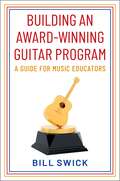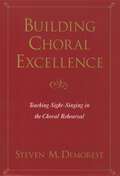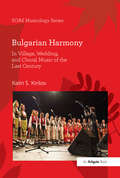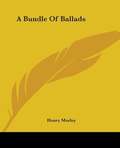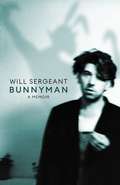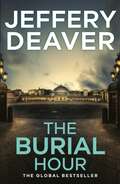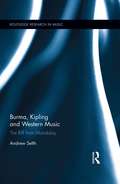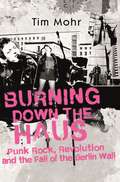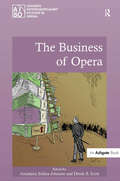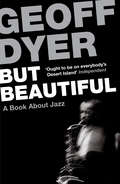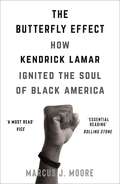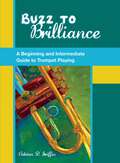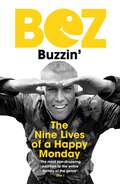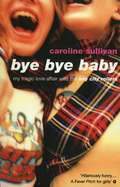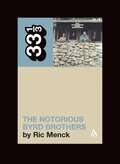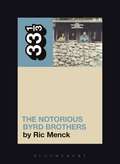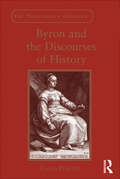- Table View
- List View
Building an Award-Winning Guitar Program: A Guide for Music Educators
by Bill SwickBuilding an Award-Winning Guitar Program is a practical guide to assist secondary and post-secondary music educators with the tasks involved in establishing a successful music program. With the rising interest in guitar, Mariachi, rock band, handbells, bluegrass, music technology, and so on, more and more music educators are being asked to teach innovative music classes. Author Bill Swick has crafted this book to help these educators build such innovative music programs from the ground floor, based on his years of experience as a music educator specialized in guitar. The book will assist music educators with classroom management, scheduling, structure, organization, fund raising, festivals, travel, and other subjects related to teaching guitar in the classroom, but its principles are broadly relevant to any and all music educators hoping to create a unique program that stands out within their school district and state, attracting students, parents, educators and administrators alike.
Building Choral Excellence: Teaching Sight-Singing in the Choral Rehearsal
by Steven M. DemorestDesigned for both the practicing choral director and the choral methods student, this is a compact and comprehensive overview of the many teaching methods, strategies, materials, and assessments available for choral sight-singing instruction. Sight-singing is an important, if sometimes neglected, facet of choral music education that often inspires fear and uncertainty in student and teacher alike. Written in an accessible style, this book takes the mystery out of teaching music reading. Topics covered include the history of sight-singing pedagogy and research, prominent methods and materials, and practical strategies for teaching and assessment. This is the only book to provide such a wealth of information under one cover and will become an essential part of every choral conductor's library.
Building Choral Excellence: Teaching Sight-Singing in the Choral Rehearsal
by Steven M. DemorestDesigned for both the practicing choral director and the choral methods student, this is a compact and comprehensive overview of the many teaching methods, strategies, materials, and assessments available for choral sight-singing instruction. Sight-singing is an important, if sometimes neglected, facet of choral music education that often inspires fear and uncertainty in student and teacher alike. Written in an accessible style, this book takes the mystery out of teaching music reading. Topics covered include the history of sight-singing pedagogy and research, prominent methods and materials, and practical strategies for teaching and assessment. This is the only book to provide such a wealth of information under one cover and will become an essential part of every choral conductor's library.
Bulgarian Harmony: In Village, Wedding, and Choral Music of the Last Century (SOAS Studies in Music Series)
by Kalin S. KirilovAn in-depth study of the Bulgarian harmonic system is long overdue. More than two decades since the Le Mystère des Voix Bulgares choir was awarded a Grammy (1990), there is no scholarly study of the captivating sounds of Bulgarian vertical sonorities. Kalin Kirilov traces the gradual formation of a unique harmonic system that developed in three styles of Bulgarian music: village music from the 1930s to the 1990s, wedding music from the 1970s to 2000, and choral arrangements (obrabotki) - creations of the socialist period (1944-1989), popularized by Le Mystère des Voix Bulgares. Kirilov classifies the different approaches to harmony and situates them in their historical and cultural contexts, establishing new systems for analysis. In the process, he introduces a new system for the categorization of scales. Kirilov argues that the ready-made concepts that are frequently forced onto Bulgarian music - ‘westernization’, ‘socialist’ or ‘Middle Eastern influence’, are not only outdated but also too vague to be of use in understanding the sophisticated modal and harmonic systems found in Bulgarian music. As an insider who has performed, composed and arranged this music for 30 years, Kirilov is uniquely qualified to interpret it for an international audience.
Bulgarian Harmony: In Village, Wedding, and Choral Music of the Last Century (SOAS Studies in Music Series)
by Kalin S. KirilovAn in-depth study of the Bulgarian harmonic system is long overdue. More than two decades since the Le Mystère des Voix Bulgares choir was awarded a Grammy (1990), there is no scholarly study of the captivating sounds of Bulgarian vertical sonorities. Kalin Kirilov traces the gradual formation of a unique harmonic system that developed in three styles of Bulgarian music: village music from the 1930s to the 1990s, wedding music from the 1970s to 2000, and choral arrangements (obrabotki) - creations of the socialist period (1944-1989), popularized by Le Mystère des Voix Bulgares. Kirilov classifies the different approaches to harmony and situates them in their historical and cultural contexts, establishing new systems for analysis. In the process, he introduces a new system for the categorization of scales. Kirilov argues that the ready-made concepts that are frequently forced onto Bulgarian music - ‘westernization’, ‘socialist’ or ‘Middle Eastern influence’, are not only outdated but also too vague to be of use in understanding the sophisticated modal and harmonic systems found in Bulgarian music. As an insider who has performed, composed and arranged this music for 30 years, Kirilov is uniquely qualified to interpret it for an international audience.
A Bundle of Ballads
by Henry MorleyHenry Morley (15 September 1822 – 1894) was a writer on English literature and one of the earliest Professors of English Literature. The son of an apothecary, he was born in Hatton Garden, London, educated at a Moravian school in Germany, and at King's College London, and after practicing medicine and keeping schools at various places, went in 1850 to London, and adopted literature as his profession. This book is a collection of his ballads.
Bunnyman: A Memoir
by Will SergeantGrowing up in Liverpool in the 1960s and '70s, when skinheads, football violence and fear of just about everything was the natural order of things, a young Will Sergeant found the emerging punk scene provided a shimmer of hope amongst a crumbling city still reeling from the destruction of the Second World War. From school-day horrors and mud flinging fun to nights at Liverpool's punk club, Eric's, Sergeant was fuelled by and thrived on music. It was this devotion that led to the birth of the Bunnymen, to the days when he and Ian McCulloch would muck around with reel-to-reel recordings of song ideas in the back parlour of his parents' council estate house, and to finding a community - friends, enemies and many in between - with those who would become post-punk royalty from the likes of Dead or Alive, Frankie Goes to Hollywood and the Teardrop Explodes to name a few.It was an uphill struggle to carve their name in the history of Liverpool music, but Echo and the Bunnymen became iconic, with songs like 'Lips Like Sugar,' 'The Cutter' and 'The Killing Moon'. By turns wry, explicit and profound, Bunnyman reveals what it was really like to be part of one of the most important British bands of the 1980s.
The Burial Hour: Lincoln Rhyme Book 13 (Lincoln Rhyme Thrillers #1)
by Jeffery DeaverFrom the author of The Goodbye Man, discover Jeffery Deaver's chilling series that inspired the film starring Angelina Jolie and Denzel Washington, and is now a major NBC TV series Number one bestselling author and master of suspense Jeffery Deaver returns with the thirteenth Lincoln Rhyme thriller, which sees a crime go global . . .When a man is snatched from a New York street in broad daylight, the only clue is a miniature noose left on the pavement. By the time criminal forensic scientist Lincoln Rhyme is involved, a video of the missing man is already online, his dying breaths set to a grisly music by someone calling himself The Composer. Rhyme and fellow investigator Amelia Sachs must follow The Composer across the globe as he continues his horrifying creation, kidnapping further victims to add their last breaths to his piece. But with Rhyme and Sachs in a whole new world with its own rules, how can they possibly guess what danger they're in when the music finally stops?'If you want thrills, Deaver is your man' Guardian'One of the most consistent writers of clever, entertaining and often thought-provoking thrillers in the world' Simon Kernick'Deaver is a master of plot twists, and they are abundant in this story...essential for fans of the franchise' Daily Mail
Burma, Kipling and Western Music: The Riff from Mandalay (Routledge Research in Music)
by Andrew SelthFor decades, scholars have been trying to answer the question: how was colonial Burma perceived in and by the Western world, and how did people in countries like the United Kingdom and United States form their views? This book explores how Western perceptions of Burma were influenced by the popular music of the day. From the First Anglo-Burmese War of 1824-6 until Burma regained its independence in 1948, more than 180 musical works with Burma-related themes were written in English-speaking countries, in addition to the many hymns composed in and about Burma by Christian missionaries. Servicemen posted to Burma added to the lexicon with marches and ditties, and after 1913 most movies about Burma had their own distinctive scores. Taking Rudyard Kipling’s 1890 ballad ‘Mandalay’ as a critical turning point, this book surveys all these works with emphasis on popular songs and show tunes, also looking at classical works, ballet scores, hymns, soldiers’ songs, sea shanties, and film soundtracks. It examines how they influenced Western perceptions of Burma, and in turn reflected those views back to Western audiences. The book sheds new light not only on the West’s historical relationship with Burma, and the colonial music scene, but also Burma’s place in the development of popular music and the rise of the global music industry. In doing so, it makes an original contribution to the fields of musicology and Asian Studies.
Burma, Kipling and Western Music: The Riff from Mandalay (Routledge Research in Music)
by Andrew SelthFor decades, scholars have been trying to answer the question: how was colonial Burma perceived in and by the Western world, and how did people in countries like the United Kingdom and United States form their views? This book explores how Western perceptions of Burma were influenced by the popular music of the day. From the First Anglo-Burmese War of 1824-6 until Burma regained its independence in 1948, more than 180 musical works with Burma-related themes were written in English-speaking countries, in addition to the many hymns composed in and about Burma by Christian missionaries. Servicemen posted to Burma added to the lexicon with marches and ditties, and after 1913 most movies about Burma had their own distinctive scores. Taking Rudyard Kipling’s 1890 ballad ‘Mandalay’ as a critical turning point, this book surveys all these works with emphasis on popular songs and show tunes, also looking at classical works, ballet scores, hymns, soldiers’ songs, sea shanties, and film soundtracks. It examines how they influenced Western perceptions of Burma, and in turn reflected those views back to Western audiences. The book sheds new light not only on the West’s historical relationship with Burma, and the colonial music scene, but also Burma’s place in the development of popular music and the rise of the global music industry. In doing so, it makes an original contribution to the fields of musicology and Asian Studies.
Burning Down The Haus: Punk Rock, Revolution and the Fall of the Berlin Wall
by Tim MohrLONGLISTED FOR THE CARNEGIE MEDAL FOR EXCELLENCE'Mohr digs into the subject of East German punk like nobody before' Rolling Stone GermanyTim Mohr brings us the secret history of punks in East Germany. Burning Down the Haus is a reclamation and an exaltation of youth culture and idealism as not only an instigator for discourse, but as an actual catalyst for political upheaval and radical change.It began with a handful of East Berlin teens who heard the Sex Pistols on a British military radio broadcast to troops in West Berlin, and it ended with the collapse of the East German dictatorship. Punk rock was a life-changing discovery: in an authoritarian state where the future was preordained, punk, with its rejection of society and DIY approach to building a new one, planted the seeds for revolution.As these kids began to form bands, they also became more visible, and security forces - including the dreaded secret police, the Stasi - targeted them. They were spied on by friends and family; they were expelled from schools and fired from jobs; they were beaten by police and imprisoned. But instead of conforming, the punks fought back, playing an indispensable role in the underground movement that helped bring down the Berlin Wall.Rollicking, cinematic and thrillingly topical, this secret history brings to life the young men and women who successfully fought authoritarianism three chords at a time. Burning Down the Haus is a fiery testament to the irrepressible spirit of revolution.'Burning Down the Haus is not just an immersion into the punk rock scene of East Berlin, it's the story of the cultural and political battles that have shaped the world we live in today' DW Gibson, author of The Edge Becomes the Center: An Oral History of Gentrification in the Twenty-First Century
The Business of Music (Liverpool Music Symposium #2)
by Michael TalbotIs business, for music, a regrettable necessity or a spur to creativity? Are there limits to the influence that economic factors can or should exert on the musical imagination and its product? In the eleven essays contained in this book the authors wrestle with these questions from the perspective of their chosen area of research. The range is wide: from 1700 to the present day; from the opera house to the community centre; from composers, performers and pedagogues to managers, publishers and lawyers; from piano miniatures to folk music and pop CDs. If there is a consensus, it is that music serves its own interests best when it harnesses business rather than denying it.
The Business of Opera (Ashgate Interdisciplinary Studies in Opera)
by Anastasia Belina-Johnson Derek B. ScottThe study of the business of opera has taken on new importance in the present harsh economic climate for the arts. This book presents research that sheds new light on a range of aspects concerning marketing, audience development, promotion, arts administration and economic issues that beset professionals working in the opera world. The editors' aim has been to assemble a coherent collection of essays that engage with a single theme (business), but differ in topic and critical perspective. The collection is distinguished by its concern with the business of opera here and now in a globalized market. This includes newly commissioned operas, sponsorship, state funding, and production and marketing of historic operas in the twenty-first century.
The Business of Opera (Ashgate Interdisciplinary Studies in Opera)
by Anastasia Belina-Johnson Derek B. ScottThe study of the business of opera has taken on new importance in the present harsh economic climate for the arts. This book presents research that sheds new light on a range of aspects concerning marketing, audience development, promotion, arts administration and economic issues that beset professionals working in the opera world. The editors' aim has been to assemble a coherent collection of essays that engage with a single theme (business), but differ in topic and critical perspective. The collection is distinguished by its concern with the business of opera here and now in a globalized market. This includes newly commissioned operas, sponsorship, state funding, and production and marketing of historic operas in the twenty-first century.
But Beautiful: A Book About Jazz
by Geoff DyerLester Young fading away in a hotel room; Charles Mingus storming down the streets of New York on a too-small bicycle; Thelonius Monk creating his own private language on the piano. . . In eight poetically charged vignettes, Geoff Dyer skilfully evokes the embattled lives of the players who shaped modern jazz. He draws on photos and anecdotes, but music is the driving force of But Beautiful and Dyer brings it to life in luminescent and wildly metaphoric prose that mirrors the quirks, eccentricity, and brilliance of each musician's style.
The Butterfly Effect: How Kendrick Lamar Ignited the Soul of Black America
by Marcus Moore'Kendrick Lamar understands and employs blues, jazz, and soul in his music, which makes it startling. His work is more than merely brilliant; it is magic' Toni Morrison'Lamar is a man living on a real and metaphorical peak, with one eye trained on the heavens, the other searching for stories in the valley below' Guardian __________Kendrick Lamar is at the top of his game. He has been described as the poet Laurette of hip-hop, perceptive, philosophical, unapologetic, fearless, and an innovative storyteller whose body of work has been compared to James Joyce and James Baldwin. He is a visionary who will go down as history as one of the most important artists of all time. But what's so striking about Kendrick Lamar, aside from his impressive accolades, is how he's effectively established himself as a formidable opponent of oppression, a force for change. Through his confessional poetics, his politically charged anthems, and his radical performances, Lamar has become a beacon of light for many people in America. Written by veteran journalist and music critic Marcus J. Moore, this is the first biography of Kendrick Lamar. It's the definitive account of his coming-of-age as an artist, his resurrection of jazz, his profound impact on a racially fraught America, and his emergence as the bona fide King of Rap.The book traces not only Lamar's powerful impact on music but also on our current society, especially under the weight of police brutality, divisive politics, and social injustice. With exclusive interviews with his family, friends, and record producers, this book is the must-read for any fan.The Butterfly Effect is the extraordinary, triumphant story of a modern lyrical prophet and an American icon who has given hope to those buckling under the weight of systemic oppression, reminding everyone that through it all, "we gon' be alright".__________'By the end of listening to his first full album, I felt like I knew everything about him. He brings you into his world with his lyrics in a way that really paints a clear picture' Eminem 'I love everything about his music. I can literally listen to his music and become a kid growing up with all the struggles in the inner city, but at the same time [learn] all the lessons it taught that we use as men today.' Lebron James'For a gentle dude, he throws a righteous punch; I wouldn't get in the way of it. No single artist will ever be the antidote to a generation's malaise, but just identifying some of the problems really helps' Bono'Kendrick Lamar is a master of storytelling' New Yorker
Buzz to Brilliance: A Beginning and Intermediate Guide to Trumpet Playing
by Adrian GriffinBuzz to Brilliance engages students personally, technically and musically as they begin their study on the trumpet. The book journeys with students from the moment they first open their trumpet case to years later as they prepare for college auditions. It abounds with technical information and practical tips including buying a new trumpet, mouthpiece selection, adjusting to braces, and marching band. Chapters on practice skills, sight-reading, and performing are a must-read for any musician, while special features give students a window into diverse worlds, from the workbench of a master repairman to the French horn studio of a master teacher. Drawings, diagrams and pictures invite students into each page, making even advanced technical concepts easy to understand. Following the written portion of the book, a comprehensive set of scales and technique-building exercises address topics including breathing, high range, pedal tones, lip slurs, accuracy, articulation, and pedal tones. With practice schedules, mouthpiece comparison chart, pitch tendencies and more, this book is a treasure for any trumpet player. Buzz to Brilliance is the perfect companion for any beginning method book, and the first text on the market that provides a comprehensive set of essential studies selected specifically for beginning and intermediate players.
Buzz to Brilliance: A Beginning and Intermediate Guide to Trumpet Playing
by Adrian GriffinBuzz to Brilliance engages students personally, technically and musically as they begin their study on the trumpet. The book journeys with students from the moment they first open their trumpet case to years later as they prepare for college auditions. It abounds with technical information and practical tips including buying a new trumpet, mouthpiece selection, adjusting to braces, and marching band. Chapters on practice skills, sight-reading, and performing are a must-read for any musician, while special features give students a window into diverse worlds, from the workbench of a master repairman to the French horn studio of a master teacher. Drawings, diagrams and pictures invite students into each page, making even advanced technical concepts easy to understand. Following the written portion of the book, a comprehensive set of scales and technique-building exercises address topics including breathing, high range, pedal tones, lip slurs, accuracy, articulation, and pedal tones. With practice schedules, mouthpiece comparison chart, pitch tendencies and more, this book is a treasure for any trumpet player. Buzz to Brilliance is the perfect companion for any beginning method book, and the first text on the market that provides a comprehensive set of essential studies selected specifically for beginning and intermediate players.
Buzzin': The Nine Lives of a Happy Monday
by BezAt the height of his initial, turn-of-the-1990's infamy as the maraca-wielding dancer with 'Madchester' giants Happy Mondays, the pop-eyed Mark Berry, forever known to the world as Bez, was visibly a danger to society. He became the so-called Chemical Generation's bug-eyed pied piper, every weekend leading millions out to oblivion and beyond, as they adopted his E-gobbling party lifestyle.Neither an accomplished musician nor even a very good dancer, Bez was a prime candidate for fleeting celebrity, soon to sink into 'Where Are They Now?' obscurity. That, however, never happened, nor does it show any sign of happening. Through Black Grape, the second band he co-fronted with the Mondays' Shaun Ryder, and his ever-presence in the mass media, Bez's popularity has grown exponentially, his star rocketing ever upwards.When he bowled into Celebrity Big Brother in 2005, he ended up winning the series, as viewers came to understand his fundamental decency and sunny outlook. His adult life has been extraordinary: unbelievable scrapes with mortality, periods of financial ruin, mindfuck moments like when David Bowie genuflected before him, and enough narcotic-strewn hi-jinx to fill several more volumes of memoir.This is the story of a bad lad who has turned his life good, tracing his passage from early-thirty-something casualty to middle-aged politician, eco-warrior and bee-aficionado.
Bye Bye Baby: My Tragic Love Affair With The Bay City Rollers
by Caroline SullivanOver four hot summers from 1975 to 1979, teenager Caroline Sullivan and her friends criss-crossed the USA in the Rollers' wake. They staked out airports and hotels, tricking airline clerks and wheedling information out of PR companies.
Byrd Studies in the Twenty-First Century (Clemson University Press: Studies in British Musical Cultures)
Byrd Studies in the Twenty-First Century demonstrates current approaches to Byrd studies in the twenty-first century and represents the sole major print effort to commemorate the 400th anniversary of the composer’s death in 2023. The volume's chapters, by both early-career and established scholars, cover topics that engage with Byrd’s milieu and music, incorporating themes such as reception history, exploration and exile, historiography, digital scholarship, literary criticism, and reconstruction. It also expands upon established areas of Byrd scholarship, including Byrd’s Catholicism, analysis, performance practice, and reformation politics, investigating how approaches to Byrd and his music have changed over since the last major anniversary in 1923. This timely volume not only marks the quatercentenary of a beloved English composer but works to situate scholarship on Byrd within the changing landscape of interdisciplinary music study. It includes contributions from scholars drawing widely from literary studies, visual culture, music theory, performance studies, and cultural history. Byrd's exceptional life at the heart of elite and courtly culture during tumultuous late-Elizabethan England is a unique window to late-sixteenth, early-seventeenth century England that will be of value to scholars and students from both within and without music studies. Byrd Studies in the Twenty-first Century provides new approaches and perspectives on Byrd's music, performance, and legacy.
The Byrds' The Notorious Byrd Brothers (33 1/3)
by Ric MenckBy the time Roger McGuinn, David Crosby, Chris Hillman, and Michael Clarke entered the studio to begin work on this album, they were basically falling apart at the seams. "Ladyfriend", a song written by Crosby, had just failed miserably as a chart single despite the fact that he lobbied hard to get it released. This - coupled with the fact that he made what the rest of the band considered an embarrassing political speech onstage during their set at the Monterey Pop Festival, and then sat in with rivals the Buffalo Springfield the following day - pushed McGuinn and Hillman in particular to the limits of their patience. Then, for the Notorious sessions, Crosby presented a song called "Triad", written about a threesome, and although McGuinn and Hillman reluctantly agreed to record it, they later decided to place a less controversial Goffin & King pop number called "Goin' Back" on the album instead. Crosby declared the song banal and refused to sing on it. A few too many studio flare-ups later, McGuinn and Hillman finally screeched up into the Hollywood Hills in their Jaguars and fired Crosby on the spot. Also brooding during this period was drummer Michael Clarke, who had always borne the brunt of the other band members' rage while recording. He was by far the least accomplished member of the band musically, and when they suggested bringing in a studio drummer to embellish some tracks (Jim Gordon, later of Derek & the Dominos fame), he finally declared he'd had enough and moved to Hawaii to get away from the music scene altogether. So, McGuinn and Hillman were left to cobble together an album with the help of producer Gary Usher (known for his work with Brian Wilson, the Millenium, Sagittarius and many others). The fact that it turned out to be one of the defining albums of the 60s psychedelic pop experience was either a sheer stroke of luck, or a testament to McGuinn and Hillman's determination to prove that they didn't need Crosby's help to construct their masterpiece.
The Byrds' The Notorious Byrd Brothers (33 1/3)
by Ric MenckBy the time Roger McGuinn, David Crosby, Chris Hillman, and Michael Clarke entered the studio to begin work on this album, they were basically falling apart at the seams. "Ladyfriend", a song written by Crosby, had just failed miserably as a chart single despite the fact that he lobbied hard to get it released. This - coupled with the fact that he made what the rest of the band considered an embarrassing political speech onstage during their set at the Monterey Pop Festival, and then sat in with rivals the Buffalo Springfield the following day - pushed McGuinn and Hillman in particular to the limits of their patience. Then, for the Notorious sessions, Crosby presented a song called "Triad", written about a threesome, and although McGuinn and Hillman reluctantly agreed to record it, they later decided to place a less controversial Goffin & King pop number called "Goin' Back" on the album instead. Crosby declared the song banal and refused to sing on it. A few too many studio flare-ups later, McGuinn and Hillman finally screeched up into the Hollywood Hills in their Jaguars and fired Crosby on the spot. Also brooding during this period was drummer Michael Clarke, who had always borne the brunt of the other band members' rage while recording. He was by far the least accomplished member of the band musically, and when they suggested bringing in a studio drummer to embellish some tracks (Jim Gordon, later of Derek & the Dominos fame), he finally declared he'd had enough and moved to Hawaii to get away from the music scene altogether. So, McGuinn and Hillman were left to cobble together an album with the help of producer Gary Usher (known for his work with Brian Wilson, the Millenium, Sagittarius and many others). The fact that it turned out to be one of the defining albums of the 60s psychedelic pop experience was either a sheer stroke of luck, or a testament to McGuinn and Hillman's determination to prove that they didn't need Crosby's help to construct their masterpiece.
Byron and the Discourses of History (The Nineteenth Century Series)
by Carla PomarèIn her study of the relationship between Byron’s lifelong interest in historical matters and the development of history as a discipline, Carla Pomarè focuses on drama (the Venetian plays, The Deformed Transformed), verse narrative (The Siege of Corinth, Mazeppa) and dramatic monologue (The Prophecy of Dante), calling attention to their interaction with historiographical and pseudo-historiographical texts ranging from monographs to dictionaries, collections of apophthegms, autobiographies and prophecies. This variety of discourses, Pomarè suggests, not only served as a source of the historical information Byron cherished, providing the subject matter for countless episodes in his works, but also and primarily supplied him with epistemological models. From them, Byron drew such trademark textual practices as his massive use of notes and paratexts, which satisfied his ingrained need for ’authenticity’ - a sentiment expressed in his oft-quoted, ’I hate things all fiction’. As Pomarè argues, Byron’s meticulous tracing of the process that links events, documents and historical representations ultimately answers his desire to retrieve what might be lost during the transmission of historical knowledge. Thus does he betray his preoccupation with the ideological uses of history writing, projecting his own discourses of history into the present of their composition.
Byron and the Discourses of History (The Nineteenth Century Series)
by Carla PomarèIn her study of the relationship between Byron’s lifelong interest in historical matters and the development of history as a discipline, Carla Pomarè focuses on drama (the Venetian plays, The Deformed Transformed), verse narrative (The Siege of Corinth, Mazeppa) and dramatic monologue (The Prophecy of Dante), calling attention to their interaction with historiographical and pseudo-historiographical texts ranging from monographs to dictionaries, collections of apophthegms, autobiographies and prophecies. This variety of discourses, Pomarè suggests, not only served as a source of the historical information Byron cherished, providing the subject matter for countless episodes in his works, but also and primarily supplied him with epistemological models. From them, Byron drew such trademark textual practices as his massive use of notes and paratexts, which satisfied his ingrained need for ’authenticity’ - a sentiment expressed in his oft-quoted, ’I hate things all fiction’. As Pomarè argues, Byron’s meticulous tracing of the process that links events, documents and historical representations ultimately answers his desire to retrieve what might be lost during the transmission of historical knowledge. Thus does he betray his preoccupation with the ideological uses of history writing, projecting his own discourses of history into the present of their composition.
